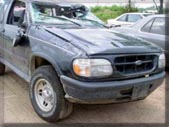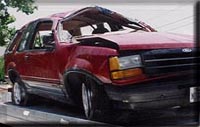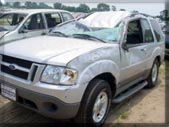Ford Explorer Rollovers
1997 Ford
Explorer Rollover - 1994 Ford Explorer Rollover - 2001 Ford Explorer Rollover
Ford Explorer
History - A Rollover Waiting to Happen
When Ford first introduced the Explorer, it soon became a marketing dream
— the perfect vehicle for a baby-boom generation that wanted it
all. You could use it as your family car, and it had the rugged, adventurous
image of a truck. The problem however was, it was still a big, tall truck
& it rolled over more easily than a passenger car would.
The roots of that
problem lie in Ford's original design decision to build the new sport
utility on the skeleton (frame) of a pickup truck instead of all in one
piece, like a car. Ford was under pressure to compete with General Motors
new SUV to be called the Blazer and to tap into the emerging new market
opened up by Jeep and the Jeep CJ craze. The rollover problem had not
become a priority until a controversy erupted in the late 1980's over
the rollover record of the Bronco II, which was also based on a Ranger
pickup truck underbody. Ford however did not learn from its past mistakes.
Using the Ranger's underbody for the Explorer too, this gave Ford the
image it wanted, with the budget it needed. But while the Explorer looked
roomy, its design actually limited the weight it could safely carry. By
extending the passenger compartment and installing a second row of seats,
Ford made the Explorer more than 600 pounds heavier than the Ranger, but
did not upgrade the suspension and tires to carry the bigger load. That
meant a typically equipped Explorer could carry 1,025 pounds, even less
than the 1,100 pounds for a Taurus. Many Explorers are built to carry
as little as 900 pounds —a 150-pound person in each of five seats
and 150 pounds of cargo.
Ford Firestone
Tire Problems
Ford also chose
the same size tires it had long chosen for the Ford Ranger. Those tires
had the lowest possible rating for withstanding high temperatures. And
when Ford lowered the recommended tire pressure in 1989 to increase stability
and soften the ride, it also further reduced the tires' ability to carry
weight without overheating. Tire pressure has of course become an issue
in the Firestone controversy, with Firestone arguing that the lower recommended
pressure — 26 pounds per square inch, compared with 35 for the Ranger
— had contributed to the tires' failure, especially where Explorers
were being driven at high speeds in during the hot summer months. When
the Explorer was introduced, Ford was concerned enough about its stability
that it advised owners to maintain a relatively low tire pressure of 26
pounds per square inch, because softer tires help an out-of-control vehicle
to slide rather than tip over. Yet the redesign in the '95 model year
made the Explorer's center of gravity slightly higher and the stability
index--a rough measure of rollover propensity--slightly worse, records
show.
Ford Explorer
Problems - Ford Scraps Twin I-Beam Suspension System
When Explorer production
began in early 1990, Ford was already at work on a redesigned version
for the '95 model year. Among the biggest changes: scrapping the twin
I-beam in favor of a short-long-arm front suspension, or SLA. The switch
was intended to accommodate two other key changes: use of rack-and-pinion
steering and dual air bags, Ford officials say. But the new suspension
also made it possible to lower the center of gravity by lowering the position
of the engine, a memo said. But that memo, dated March 26, 1990, said
Ford had decided not to exploit the opportunity. The decision "to
retain the . . . engine position minimizes the effect on other vehicle
systems . . . but does not take advantage of the fact that the engine
could be lowered with a SLA-type suspension," the memo said. "This
decision was driven by early implementation and program cost."
Ford Explorer's
Suspension - Creates a High Center of Gravity
With the new suspension
system Ford installed in 1995 and later model Explorers, the auto maker
could have lowered the center of gravity of the top-heavy vehicles by
lowering the engine height, according to memos by Ford engineers. But
the company decided to retain the original engine position, at least partly
to hold down redesign costs and preserve profit margins of nearly 40%
on the popular Explorer, the documents show. A Ford spokesman acknowledged
a small rise in the Explorer's center of gravity with the '95 redesign,
but said the difference is inconsequential.
Ford Explorer
Roof Failures
According to a 1991
memo, the Explorer was contributing a profit that year of $559 million.
Profit margin on the vehicles was 38.8%, the document said. The 1991 memo
estimated the increased costs of the '95 redesign at $1,267 per vehicle,
despite cost-reduction programs. According to another document, one of
the economies involved using thinner metal panels to construct the Explorer's
roof.
Experts say most
vehicle roofs are extremely weak, thanks to a federal roof crush standard
that has not been changed for three decades, and was widely regarded as
ineffective at the time it was adopted. Safety advocates say the issue
is important because a major cause of deaths and paralyzing injuries in
rollover crashes is the roof collapsing onto occupants.
Ford Explorer
Rollover Litigation
The Willis Law Firm
has collected TENS of MILLIONS of DOLLARS for victims and their families involved in rollover accidents nationwide
including the Ford Explorer & other SUV rollovers, tire tread separations,
tire explosions, roof collapses, seat back failures, seatbelt releases,
lap belt defects and other serious product liability cases. If you or
a family member have been seriously injured in a Ford Explorer Rollover,
then call us immediately to see what can be done to protect your legal
rights. We have a full team of investigators, rollover engineering experts,
seatbelt experts and many other experts needed to take on Ford Motor Company
in a a complex products liability action concerning the defective design
of the Ford Explorer and why it rolls and kills !! Call us if we can be
of assistance to you.
If You
Would Like To Know More What Can Be Done to Protect Your Rights
Then
Call Us For a Free Confidential Consultation
NO FEES
or EXPENSES unless
WE RECOVER A SETTLEMENT FOR YOU
1-800-883-9858 or 1-800-468-4878

|




